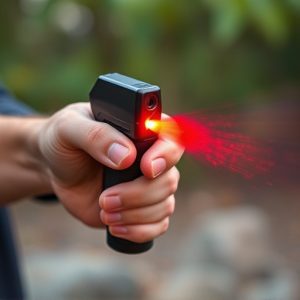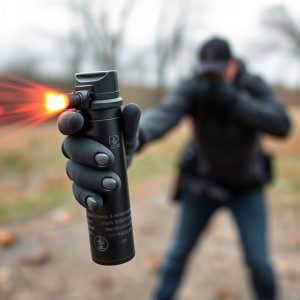Non-Lethal Pepper Spray: A Comprehensive Guide to Riot Control
Non-lethal pepper spray defense, also known as capsaicin spray or riot control spray, is a powerful…….
Non-lethal pepper spray defense, also known as capsaicin spray or riot control spray, is a powerful tool for law enforcement and individuals to protect against threats. It temporarily incapacitates targets by targeting sensory neurons, causing a burning sensation and temporary blindness without permanent harm. Effective in riots, robberies, and active shooter scenarios, it enables safe escape time or emergency service arrival. With proper training, users can deploy it accurately while minimizing risks and civil liberties concerns. Safety measures include protective gear, ventilation, and targeted deployment to legs/torso at a safe distance.
“Discover the powerful tool of non-lethal pepper spray defense in our comprehensive guide. We explore its role in riot control, focusing on ‘Understanding Non-Lethal Pepper Spray’ and ‘The Role of Riot Control Spray Canisters’. Learn how this substance works, its benefits, and safety guidelines for law enforcement. From ‘How Does Non-Lethal Pepper Spray Work?’ to ‘Safety and Deployment Considerations’, this article offers an in-depth overview, ensuring you’re informed about the latest non-lethal defense strategies.”
- Understanding Non-Lethal Pepper Spray: A Comprehensive Overview
- The Role of Riot Control Spray Canisters in Law Enforcement
- How Does Non-Lethal Pepper Spray Work?
- Benefits and Considerations for Using Riot Control Sprays
- Safety and Deployment Guidelines for Effective Use
Understanding Non-Lethal Pepper Spray: A Comprehensive Overview
Non-lethal pepper spray, also known as capsaicin spray, is a powerful defensive tool designed to incapacitate and deter potential threats without causing serious harm or death. This type of spray is a popular choice for law enforcement agencies, security personnel, and individuals seeking self-defense options due to its effectiveness in neutralizing aggressors temporarily. The active ingredient, capsaicin, is extracted from chili peppers and stimulates the sensory neurons, leading to a burning sensation and temporary blindness.
When used appropriately, non-lethal pepper spray can be an effective deterrent against various threats, including physical attacks, robberies, and mob violence. It allows users to gain time for escape or support arrival of emergency services. The spray creates a safe distance between the user and attacker, providing a crucial window of opportunity in potentially dangerous situations. With proper training, individuals can learn how to deploy this defense mechanism effectively while minimizing risks associated with its use.
The Role of Riot Control Spray Canisters in Law Enforcement
Riot control spray canisters, commonly known as pepper spray, play a significant role in law enforcement strategies worldwide. These non-lethal defensive tools are designed to incapacitate individuals temporarily, providing crucial time for officers to gain control during high-intensity situations like riots, crowd dispersals, or active shooter scenarios. The primary function is to create a safe space for both civilians and law enforcement by neutralizing the threat without causing permanent harm.
The effectiveness of riot control spray lies in its ability to deter violent behavior and enable orderly dispersal. Pepper spray can quickly disrupt an individual’s balance and breathing, leading to temporary blindness, coughing, and difficulty moving. This disruption allows officers to subdue and secure suspects, ensuring public safety. With the increasing prevalence of large gatherings and civil unrest, these spray canisters have become indispensable assets for police forces, offering a proportional and controlled approach to maintaining law and order.
How Does Non-Lethal Pepper Spray Work?
Non-lethal pepper spray, also known as oleoresin capsicum (OC) spray, is a powerful defense mechanism designed to incapacitate individuals temporarily without causing serious harm. Its primary active ingredient is capsaicin, the same compound that gives chili peppers their heat. When sprayed, capsaicin irritates the eyes, nose, and respiratory system, leading to temporary blindness, coughing, and difficulty breathing. This overwhelming sensory input disrupts an individual’s ability to continue aggressive behavior, providing a critical window of opportunity for law enforcement or security personnel to gain control and de-escalate the situation.
The spray works by targeting specific nerve endings in the body responsible for pain perception. It causes these receptors to send intense signals to the brain, leading to the release of chemicals that produce a burning sensation. This reaction is both painful and disorienting, enabling users to gain distance from potential threats. As an essential tool in riot control and crowd management, non-lethal pepper spray offers a safe and effective means of self-defense while minimizing the risk of permanent injury.
Benefits and Considerations for Using Riot Control Sprays
Riot control spray canisters, especially non-lethal pepper spray, offer a powerful tool for law enforcement and security personnel to manage chaotic situations. One of its primary benefits is its effectiveness in de-escalating violent or crowded scenes quickly and safely. The spray temporarily incapacitates individuals without causing permanent harm, allowing for easier control and management of the crowd. This method can prevent injuries to both civilians and officers and minimize damage to property.
When considering the use of riot control sprays, it’s essential to balance their advantages with potential drawbacks. For instance, pepper spray can lead to unpleasant side effects like respiratory distress or skin irritation for bystanders and individuals with certain medical conditions. Additionally, proper training is crucial; otherwise, there’s a risk of misuse or accidental harm. Effective deployment strategies and clear guidelines ensure that riot control sprays are used as a last resort, proportional to the threat, and in line with legal frameworks, balancing public safety and civil liberties.
Safety and Deployment Guidelines for Effective Use
When deploying a riot control inflammatory spray canister, safety is paramount. These non-lethal pepper spray defenses are designed to disrupt and disperse crowds, but their effectiveness hinges on proper usage. Always wear protective gear, including eye and face protection, as the spray can cause irritation or damage. Ensure adequate ventilation in the area to prevent the buildup of harmful gases. Check the canister’s expiration date and follow the manufacturer’s instructions for proper handling and storage.
For optimal deployment, aim for the legs and lower torso of individuals, as this targets their balance and movement without causing severe harm. Keep a safe distance, allowing the spray to take effect before advancing. In crowded or confined spaces, be mindful of how the spray spreads to avoid accidental inhalation by bystanders or officers. Regular training and familiarity with the equipment are crucial to ensure swift and precise use during volatile situations.
Non-lethal pepper spray, or riot control inflammatory spray, is a powerful tool in law enforcement and public safety. Its effectiveness lies in disrupting and disorienting individuals without causing serious harm. The strategic use of these spray canisters can de-escalate tense situations, providing officers with a valuable defense mechanism. By understanding their operation, benefits, and proper deployment guidelines, law enforcement agencies can ensure the safe and efficient management of crowds and potential threats, ultimately fostering a safer environment for all.


